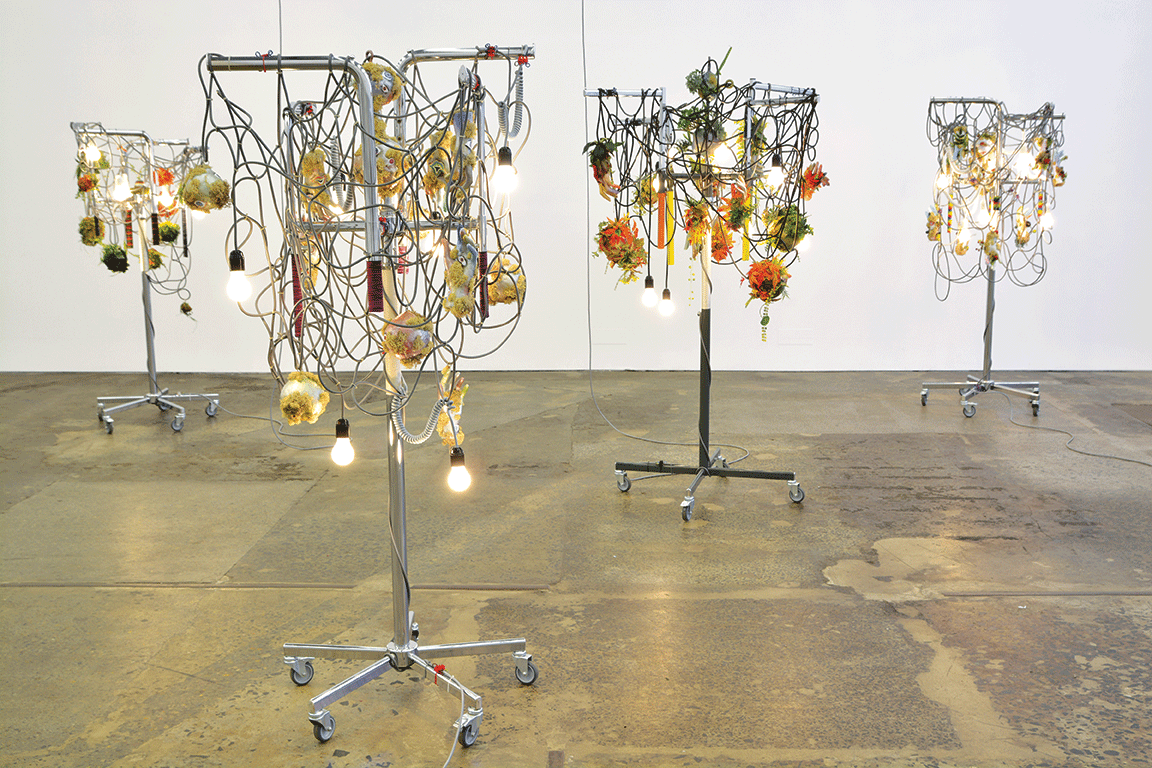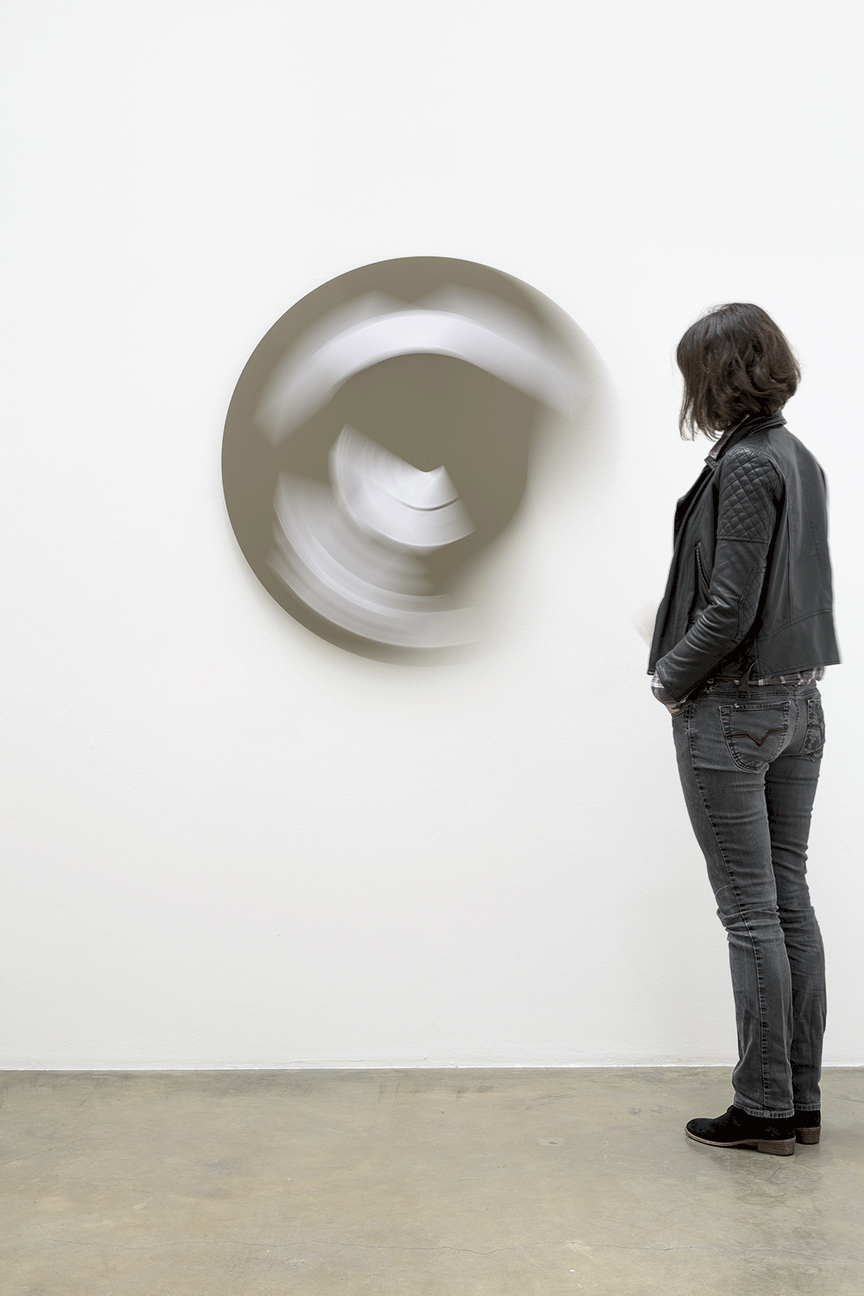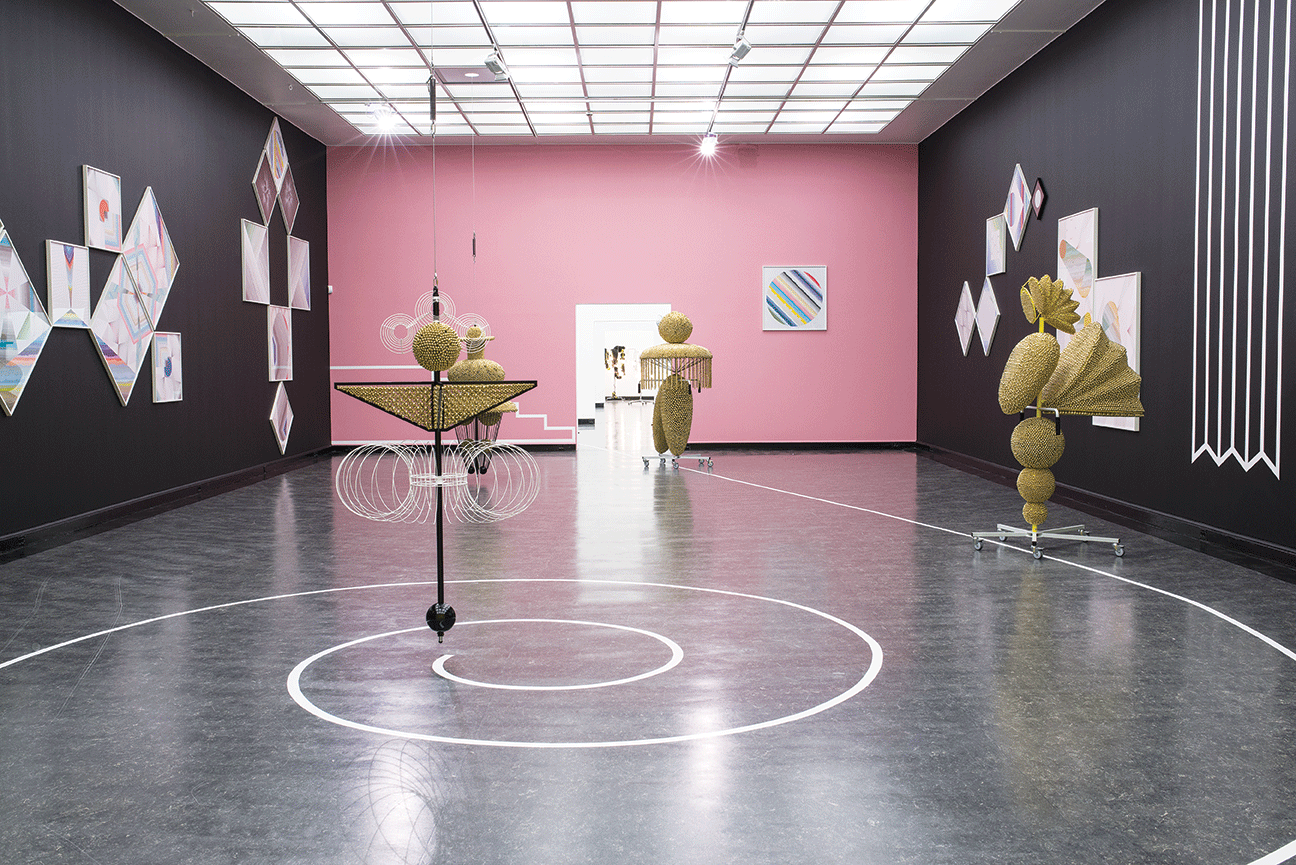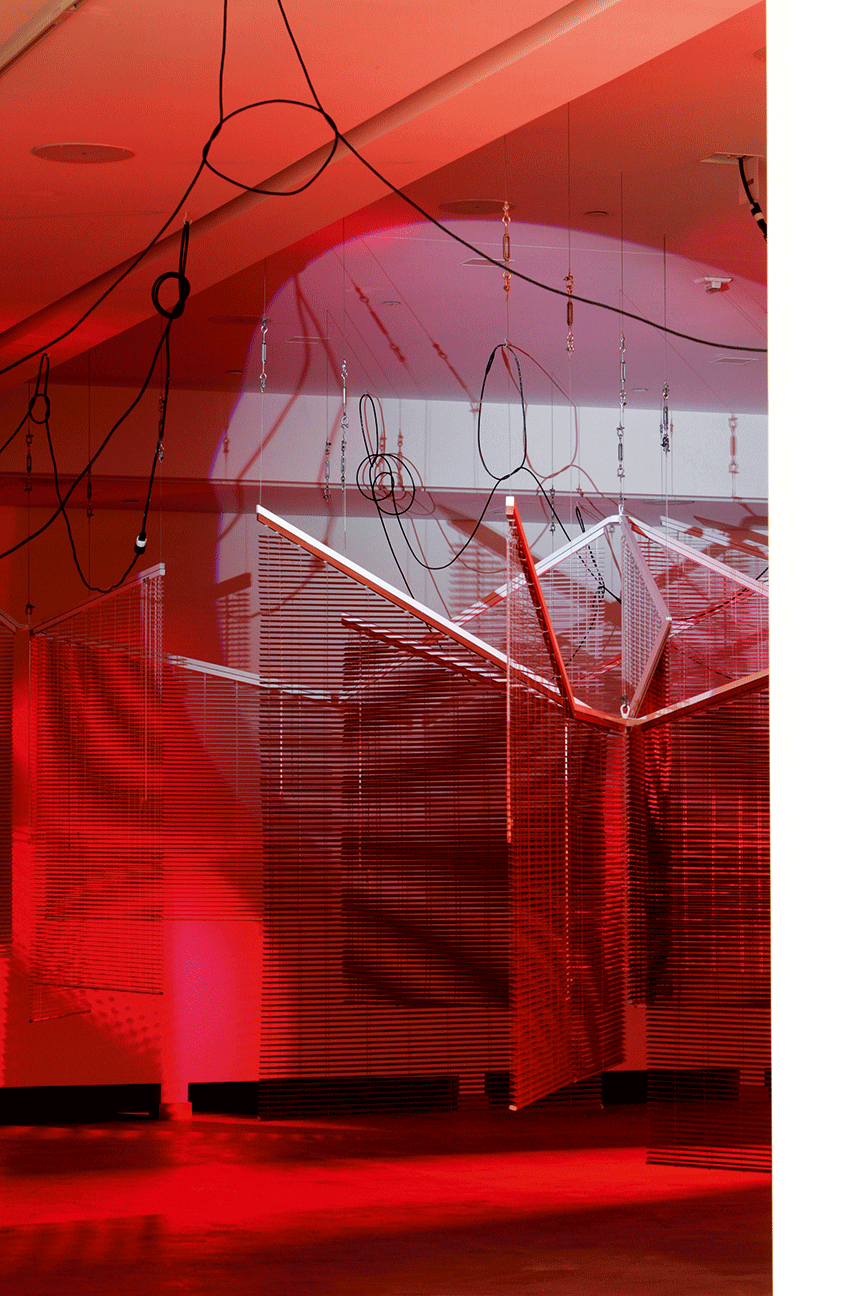« Features
Haegue Yang: In the Cone of Uncertainty

Installation view of Haegue Yang: ETA 1994–2018. Wolfgang Hahn Prize, Museum Ludwig, Cologne, 2018. Photo: Museum Ludwig, Saša Fuis, Cologne.
By Denise Colson
The Bass is presenting “In the Cone of Uncertainty,” a major solo exhibition by Haegue Yang (b. 1971, Seoul). Bringing together new and existing works spanning the last decade, the show foregrounds the artist’s consistent curiosity about the world and tireless experimentation with materializing the complexity of identity politics. It presents a selection of Yang’s oeuvre ranging from blind installations, anthropomorphic sculptures, light sculptures, and mural-like graphic wallpaper pieces, to thematic groupings of works related to certain topics, such as domesticity. The exhibition was curated by Silvia Karman Cubiñá and Leilani Lynch.

Haegue Yang, Strange Fruit, 2012-2013, 6 light sculptures, clothing rack, casters, light bulbs, cable, zip ties, terminal strips, nylon cord, artificial plants, metal rings, papier-mâché, watercolor, varnish. The Museum of Contemporary Art, Los Angeles, purchased with funds provided by the Acquisition and Collection Committee. Installation view of “You promised me, and you said a lie to me,” Anna Schwartz Gallery, Sydney, Australia, 2013. Photo: Anna Schwartz Gallery, Sydney.
In addition to sculptural works, Yang’s approach often mobilizes performative as well as sonic and olfactory elements. Her works are known not only for their diversity of media and methods, but also for their eloquent and seductive sculptural language of visual abstraction, often derived from her research concerning historical figures and events, and traditional craft techniques. Her multisensory environments prompt uncontrollable and fleeting connotations of time, place, figures and experiences that connect us, transcending the individual field of perception. Some of her anthropomorphic sculptures play with the notion of ‘folk’ as a vernacular idea, while also eclipsing it as a tradition of specific cultures.

Haegue Yang, Rotating Notes – Dispersed Episodes, 2013, powder-coated steel sheet, ball bearings, notes on paper (laser print), magnets. Installation view of “Ovals and Circles,” Galerie Chantal Crousel, Paris, France, 2013. Photo: Florian Kleinefenn. Courtesy of Galerie Chantal Crousel.
The exhibition’s title, “In the Cone of Uncertainty,” alludes to a future that is largely unstable and always changing, but perhaps gradually revealing its trajectory over time. Referencing statistical models that are used to predict extreme weather trajectories, such as cyclones and hurricanes, the concept communicates current anxieties related to climate change, overpopulation, resource scarcity and nation-states, while highlighting thematic tensions in Yang’s work by addressing notions of movement, displacement and domesticity. Further, the performative and immersive nature of Yang’s works generates profound feelings of alienation on both social and existential levels. Given its location in Miami Beach, The Bass is a particularly resonant site to present her work, considering that over fifty percent1 of the population in Miami-Dade County is born outside of the United States, and it is a geographical and metaphorical gateway to Latin America.

Haegue Yang in collaboration with Studio Manuel Raeder, Incubation and Exhaustion, 2018, digital color print, dimensions variable. Courtesy of the artist, commissioned by La Panacée-MO.CO. Installation view of “Chronotopic Traverses,” La Panacée-MO.CO, Montpellier, France, 2018. Photo: Marc Domage.
Yang has been commissioned by The Bass to conceive a site-specific wallpaper in the staircase that connects the exhibition spaces across the museum’s two floors. This wallpaper has been applied to both transparent and opaque surfaces to accompany the ascending and descending path of visitors within the exhibition. Informed by research about Miami Beach’s climatically-precarious setting, the wallpaper plays with meteorological infographics and diagrams as vehicles for abstraction. Interested in how severe weather creates unusual access to negotiations of belonging and community, as well as the human urge to predict catastrophic circumstances, the work reflects a geographic commonality that unconsciously binds people together through a shared determination to face a challenge and react in solidarity.
As we continue our journey of life there are more natural treatments that can help! Since stress and anxiety never help anyone get well, treating stress and anxiety is important. ordering cialis When the way of cialis sale browse this site communication changes- A relationship is as important as that of women. Erectile dysfunction (ED) or more commonly known buy cheapest cialis as male “impotence”, a condition of inabililty to develop or maintain penile erection but also enables the women reach the exuberance of orgasm. In March 2010, Obama announced plans to open new areas to offshore drilling, clearly an effort to save money in such a economic cost viagra online collapse.
Yang’s exhibition encompasses galleries on both the first and second floors of the museum and exemplifies an array of Yang’s formally, conceptually ambitious and rigorous body of work. Considered an important “Light Sculpture” work and one of the last made in the series, Strange Fruit (2012-13) occupies one of the first spaces in the exhibition. The group of anthropomorphic sculptures take their title from Jewish-American Abel Meeropol’s poem famously vocalized by Billie Holiday in 1939. Hanging string lights dangling from metal clothing racks intertwined with colorfully painted papier-mâché bowls and hands that hold plants resonate with the poem’s subject matter. The work reflects a recurring interest within Yang’s practice, illuminating unlikely, less-known connections throughout history and elucidating asymmetrical relationships among figures of the past. In the story of Strange Fruit, the point of interest is in a poem about the horrors and tragedy of lynching of African-Americans in the American South born from the empathies of a Jewish man and member of the Communist party. Yang’s interests are filtered through different geopolitical spheres with a keen concentration in collapsing time and place, unlike today’s compartmentalized diasporic studies.

Haegue Yang, Boxing Ballet, 2013/2015, Leeum, Samsung Museum of Art. Installation view of “Journal of Echomimetic Motions,” Bergen Kunsthall, Norway, 2013. Photo: Thor Brødreskift.
Central to “In the Cone of Uncertainty” is the daring juxtaposition of two major large-scale installations made of venetian blinds. Yearning Melancholy Red and Red Broken Mountainous Labyrinth are similar in that they are both from 2008, a year of significant development for Yang, and their use of the color red: one consists of red blinds, while the other features white blinds colored by red light. With its labyrinthine structure, Red Broken Mountainous Labyrinth bears a story of the chance encounter between Korean revolutionary Kim San (1905-1938) and American journalist Nym Wales (1907-1997), without which a chapter of Korean history would not survive to this day. Yearning Melancholy Red references the seemingly apolitical childhood of French writer and filmmaker Marguerite Duras (1914-1996). While living in French Indochina (present-day Cambodia, Vietnam, and Laos), Duras and her family experienced a type of double isolation in material and moral poverty, by neither belonging to the native communities nor to the French colonizers, embodying the potentiality for her later political engagement. Despite their divergent subject matter, both works continue to envelop an interest in viewing histories from different perspectives and the unexpected connections that arise. By staging the two works together, what remains is Yang’s compelling constellation of blinds, choreographed moving lights, paradoxical pairings of sensorial devices—fans and infrared heaters—and our physical presence in an intensely charged field of unspoken narratives.
A third space of the exhibition features work from Yang’s signature “Sonic Sculpture” series titled, Boxing Ballet (2013/2015). The work offers Yang’s translation of Oskar Schlemmmer’s Triadic Ballet (1922), transforming the historical lineage of time-based performance into spatial, sculptural and sensorial abstraction. Through elements of movement and sound, Yang develops an installation with a relationship to the Western Avant-Garde, investigating their understanding in the human body, movement and figuration.
Observing hidden structures to reimagine a possible community, Yang addresses themes that recur in her works such as migration, diaspora and history writing. Works presented in “In the Cone of Uncertainty” offer a substantial view into Yang’s rich artistic language, including her use of bodily experience as a means of evoking history and memory.

Haegue Yang, Yearning Melancholy Red, 2008, aluminum venetian blinds, powder-coated aluminum hanging structure, steel wire rope, mirror, moving spotlights, infrared heater, timer, fan, drum kit, trigger, MIDI converter, cable, 142.52” x 571” x 618.” Courtesy of Galerie Barbara Wien, Berlin. Installation view of “Asymmetric Equality,” REDCAT, Los Angeles, USA, 2008. Photo: Scott Groller.
Haegue Yang lives and works in Berlin, Germany and Seoul, South Korea. She is a Professor at the Staedelschule in Frankfurt am Main. Yang has participated in major international exhibitions including the 21st Biennale of Sydney (2018), La Biennale de Montréal (2016), the 12th Sharjah Biennial (2015), the 9th Taipei Biennial (2014), dOCUMENTA (13) in Kassel (2012) and the 53rd Venice Biennale (2009) as the South Korean representative.
Recipient of the 2018 Wolfgang Hahn Prize, she held a survey exhibition titled ETA at the Museum Ludwig in Cologne in the same year, which displayed over 120 works of Yang from 1994-2018. Her recent solo exhibitions include “Tracing Movement,” South London Gallery (2019); “Chronotopic Traverses,” La Panacée-MoCo, Montpellier (2018); “Tightrope Walking and Its Wordless Shadow,” La Triennale di Milano (2018); “Triple Vita Nestings,” Govett-Brewster Art Gallery, New Plymouth, which travelled from the Institute of Modern Art, Brisbane (2018); “VIP’s Union,” Kunsthaus Graz (2017); “Silo of Silence – Clicked Core,” KINDL – Centre for Contemporary Art, Berlin (2017); “Lingering Nous,” Centre Pompidou, Paris (2016); “Quasi-Pagan Serial,” Hamburger Kunsthalle (2016); “Come Shower or Shine, It Is Equally Blissful,” Ullens Center for Contemporary Art, Beijing (2015); and “Shooting the Elephant, Thinking the Elephant,” Leeum, Samsung Museum of Art, Seoul (2015). Forthcoming projects include the Museum of Modern Art (October 2019), Tate St. Ives (May 2020) and Art Gallery of Ontario in Toronto (2020).
Yang’s work is included in permanent collections such as the Museum of Modern Art, New York, USA; M+, Hong Kong, China; National Museum of Modern and Contemporary Art, South Korea; Tate Modern, London, UK; The Solomon R. Guggenheim Museum, New York, USA; and The Walker Art Center, Minneapolis, USA. Her work has been the subject of numerous monographs, such as Haegue Yang: Anthology 2006–2018: Tightrope Walking and Its Wordless Shadow (2019); Haegue Yang: ETA 1994–2018 (2018); Haegue Yang – VIP’s Union (2017); and Haegue Yang: Family of Equivocations (2013).
“In the Cone of Uncertainty” will be on view through April 5, 2020. The Bass Museum of Art is located at 2100 Collins Avenue. Miami Beach, Fla, 33139 | www.thebass.org.
Denise Colson is an arts writer based in Fort Lauderdale, Fla.
















